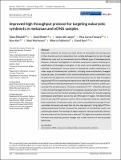Por favor, use este identificador para citar o enlazar a este item:
http://hdl.handle.net/10261/251269COMPARTIR / EXPORTAR:
 SHARE SHARE
 CORE
BASE CORE
BASE
|
|
| Visualizar otros formatos: MARC | Dublin Core | RDF | ORE | MODS | METS | DIDL | DATACITE | |

| Título: | Improved high throughput protocol for targeting eukaryotic symbionts in metazoan and eDNA samples |
Autor: | Minardi, Diana; Ryder, David; Campo, Javier del CSIC ORCID; Fonseca, Vera G.; Keer, Rose; Mortensen, Stein; Pallavicini, Alberto; Bass, David | Palabras clave: | Anti-metazoan eDNA Microeukaryote Eukaryome Metabarcoding Symbiome |
Fecha de publicación: | feb-2022 | Editor: | John Wiley & Sons | Citación: | Molecular Ecology Resources 22(2): 664-678 (2022) | Resumen: | Eukaryote symbionts of animals are major drivers of ecosystems not only because of their diversity and host interactions from variable pathogenicity but also through different key roles such as commensalism and to different types of interdependence. However, molecular investigations of metazoan eukaryomes require minimising co-amplification of homologous host genes. In this study we 1) identified a previously published ‘anti-metazoan’ reverse primer to theoretically enable amplification of a wider range of microeukaryotic symbionts, including more evolutionarily divergent sequence types, 2) evaluated in silico several anti-metazoan primer combinations, and 3) optimised the application of the best performing primer pair for high throughput sequencing (HTS) by comparing one-step and two-step PCR amplification approaches, testing different annealing temperatures and evaluating the taxonomic profiles produced by HTS and data analysis. The primer combination 574*F – UNonMet_DB tested in silico showed the largest diversity of non-metazoan sequence types in the SILVA database and was also the shortest available primer combination for broadly-targeting anti-metazoan amplification across the 18S rRNA gene V4 region. We demonstrate that the one-step PCR approach used for library preparation produces significantly lower proportions of metazoan reads, and a more comprehensive coverage of host-associated microeukaryote reads than the two-step approach. Using higher PCR annealing temperatures further increased the proportion of non-metazoan reads in all sample types tested. The resulting V4 region amplicons were taxonomically informative even when only the forward read is analysed. This region also revealed a diversity of known and putatively parasitic lineages and a wider diversity of host-associated eukaryotes. | Versión del editor: | https://doi.org/10.1111/1755-0998.13509 | URI: | http://hdl.handle.net/10261/251269 | DOI: | 10.1111/1755-0998.13509 | ISSN: | 1755-098X | E-ISSN: | 1755-0998 |
| Aparece en las colecciones: | (IBE) Artículos |
Ficheros en este ítem:
| Fichero | Descripción | Tamaño | Formato | |
|---|---|---|---|---|
| eDNA_samples.pdf | 1,33 MB | Adobe PDF |  Visualizar/Abrir |
CORE Recommender
SCOPUSTM
Citations
8
checked on 19-abr-2024
WEB OF SCIENCETM
Citations
6
checked on 24-feb-2024
Page view(s)
77
checked on 29-abr-2024
Download(s)
38
checked on 29-abr-2024
Google ScholarTM
Check
Altmetric
Altmetric
Este item está licenciado bajo una Licencia Creative Commons

